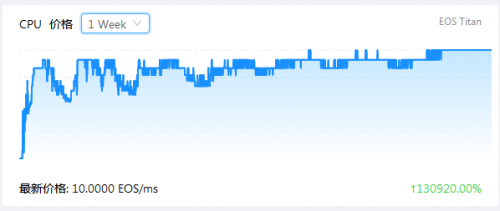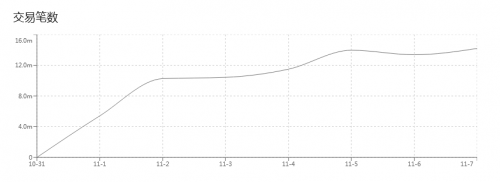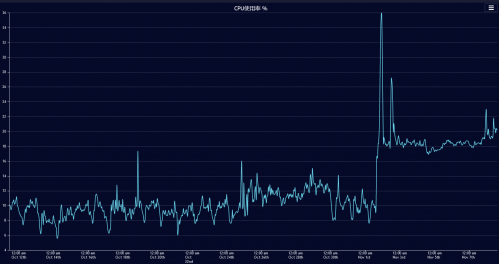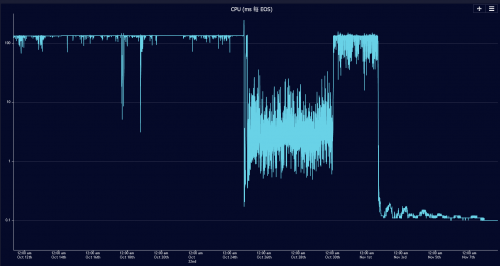EOS is now hot and the EOS is now congested, and the CPU price has increased by 1300 times.
On November 8, EOS is still in a congested state. The EOSpark data shows that the current CPU price of the EOS main network has reached a peak of 10EOS/ms, and the price has increased by 1300 times compared with a week ago (the CPU price was 0.007634 EOS/ms a week ago). According to IMEOS, most EOS users are currently unable to conduct trading operations, and need to use a third-party account to help with mortgages in order to suspend the status of the account "catch".

CPU price peaks
It is reported that the EOS congestion incident originated from November 1st, the new project EIDOS token of AidenPearce, the founder of the original avocado project, made an airdrop on EOS.
- Ant Node Alliance Zeng Hao: Shining Maltese Chinese Star Entrepreneur, Winning European Applause with Blockchain
- What are the most profitable blockchain funds going on?
- Resolution: Bitcoin block timestamp protection rules
Due to the overwhelming popularity of the wool-smashing activity, the Wool Party’s short-term high-frequency trading caused the EOS network to “collapse”. Dappreview data shows that on November 1st, the number of transactions on EIDOS exceeded 5.4 million. At present, the number of transactions in EIDOS is still at a high level of nearly 15 million times.

EIDOS's transaction number is still nearly 15 million times
One of the $100 EOS transactions consumed 24% of the DPOS (Delegate Proof of Stake) participants. And users cannot send EOS votes to support new block producers. (The block producers in EOS are elected by voting. The first 21 block production nodes with the highest votes are taken as new block producers every minute, and the voting time is all in progress. These 21 block producers Recorded on a list and then produced blocks in order of ranking.)
In response, some users have proposed "new governance… stop voting, stop trading, stop BP collusion, and only allow one vote per token."
EOS resource design is based on the user having a certain amount of tokens, free use of a certain proportion of network resources, EOS system mainly contains three resources, namely network bandwidth resources (NET), CPU computing resources (CPU), running memory resources (RAM ). Among them, the CPU is one of the resources consumed by the user when making a transfer or transaction.
In the EOS network, when the number of EOSs used to exchange CPU resources suddenly increases, the available CPU resources corresponding to one EOS are reduced. For example, if a user exchanges 10,000 EOS mortgages for 10 minutes of CPU, if the CPU has a surplus, if the DAPP team mortgages a large number of EOS, this will result in a reduction in the available CPU resources per EOS, ie 10,000 EOS. The mortgage exchanged the CPU for less than 10 minutes. In addition, if the collateral of the main network decreases, the CPU resources allocated by a single EOS will increase, which will also lead to an increase in the total quota.
According to EOSTitan data, the EOS CPU usage reached a peak of 35.82% on November 1 and is currently down to around 20%. On November 1st, the CPU cost was 130ms/EOS, and the current cost was 0.1ms/EOS.

CPU usage

CPU cost
If users get more CPUs, they need to increase the total quota, that is, mortgage more EOS to get more CPU usage; or wait for CPU resources to recover, the general recovery time is 4 hours.
At present, the allocated memory on the EOS network is over 50%, REX has been lifted by 83.33%, and the EOS price has dropped slightly. The current price is $3.49.

We will continue to update Blocking; if you have any questions or suggestions, please contact us!
Was this article helpful?
93 out of 132 found this helpful
Related articles
- Analysis: Bitcoin cash has increased fluctuations in hash rate last month. Will this continue?
- Wuzhen·Genesis Mining CEO: Only the most innovative companies and the most efficient miners can survive
- Zhang Yifeng, Wuzhen·China Banknote Block Chain Research Institute: Distributed Digital Identity is the entrance to the blockchain
- Ma Qianli, Vice President of Wuzhen Babbitt: The "Product" Thought of Industrial Blockchain
- Wuzhen • Tencent Blockchain Cai Weige: Application into the outbreak period, how to achieve the link from the chain to the chain?
- Sun Lilin, founder of Wuzhen·PlatON: Thoughts on Blockchain Governance in the Age of Privacy Computing
- Wuzhen·Baidu Blockchain Xiao Wei: Integrating blockchain, AI and other technologies to promote the construction of smart cities into a new stage





